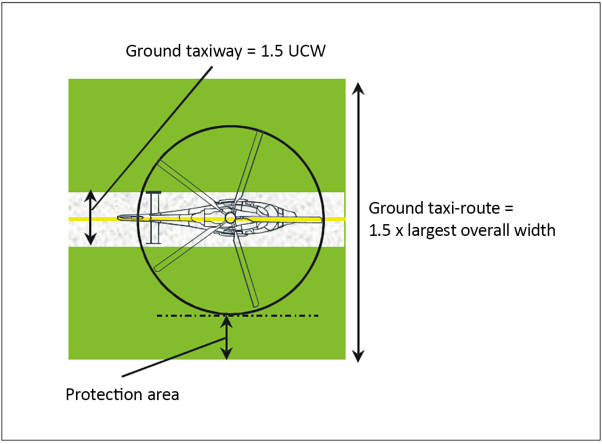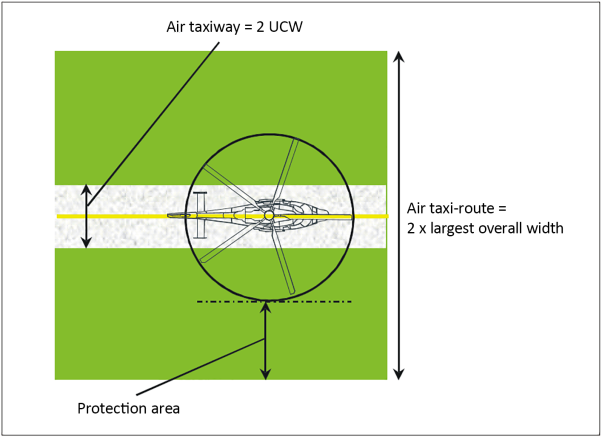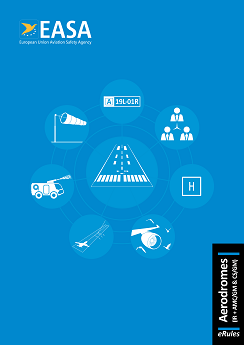CS HPT-DSN.C.200 Helicopter ground taxiways and helicopter ground taxi-routes
ED Decision 2019/012/R
(a) General: A helicopter ground taxiway should be designed to permit the surface movement of a wheeled helicopter under its own power.
(b) Characteristics:
(1) The width of a helicopter ground taxiway should not be less than 1.5 times the largest width of the undercarriage (UCW) of the helicopters the helicopter ground taxiway is intended to serve (see Figure C-1).
(2) The longitudinal slope of a helicopter ground taxiway should not exceed 3 per cent.
(3) A helicopter ground taxiway should be static load-bearing and capable of withstanding the traffic of the helicopters the helicopter ground taxiway is intended to serve.
(4) A helicopter ground taxiway should be centred on a helicopter ground taxi-route.
(5) A helicopter ground taxi-route should extend symmetrically on each side of the centre line for at least 0.75 times the largest overall width of the helicopters it is intended to serve.
(6) No fixed object should be permitted above the surface on a helicopter ground taxi-route, except for frangible objects, which, because of their function, must be located there.
(7) No mobile object should be permitted on a ground taxi-route during helicopter movements.
(8) Objects whose function requires them to be located on a helicopter ground taxi-route should not:
(i) be located at a distance of less than 50 cm from the edge of the helicopter ground taxiway; and
(ii) penetrate a plane originating at a height of 25 cm above the plane of the helicopter ground taxiway, at a distance of 50 cm from the edge of the helicopter ground taxiway and sloping upwards and outwards at a gradient of 5 per cent.
(9) The helicopter ground taxiway and the helicopter ground taxi-route should provide rapid drainage but the transverse slope of a helicopter ground taxiway should not exceed 2 per cent.
(10) The surface of a helicopter ground taxi-route should be resistant to the effect of rotor downwash.
(11) For simultaneous operations, the helicopter ground taxi-routes should not overlap.

Figure C-1. Helicopter ground taxi-route/taxiway
GM1 HPT-DSN.C.200 Helicopter ground taxiways and helicopter ground taxi-routes
ED Decision 2019/012/R
When a taxiway is intended for use by aeroplanes and helicopters, the provisions for taxiways for aeroplanes and helicopter ground taxiways will be taken into consideration and the more stringent requirements should apply.
CS HPT-DSN.C.210 Helicopter air taxiways and helicopter air taxi-routes
ED Decision 2019/012/R
(a) General: A helicopter air taxiway should be designed so as to permit the movement of a helicopter above the surface at a height normally associated with ground effect and at ground speed less than 37 km/h (20 kt).
(b) Characteristics:
(1) The width of a helicopter air taxiway should be at least two times the largest width of the undercarriage (UCW) of the helicopters that the helicopter air taxiway is intended to serve (see Figure C-2).
(2) The surface of a helicopter air taxiway should be static load-bearing.
(3) The slopes of the surface of a helicopter air taxiway should not exceed the slope landing limitations of the helicopters the helicopter air taxiway is intended to serve.
(4) The transverse slope of a helicopter air taxiway should not exceed 10 per cent.
(5) The longitudinal slope of a helicopter air taxiway should not exceed 7 per cent.
(6) A helicopter air taxiway should be centred on a helicopter air taxi-route.
(7) A helicopter air taxi-route should extend symmetrically on each side of the centre line for a distance at least equal to the largest overall width of the helicopters it is intended to serve.
(8) No fixed object should be permitted above the surface on an air taxi-route, except for frangible objects, which, because of their function, must be located there.
(9) No mobile object should be permitted on an air taxi-route during helicopter movements.
(10) Objects above ground level whose function requires them to be located on a helicopter air taxi route should not:
(i) be located at a distance of less than 1 m from the edge of the helicopter air taxiway, or at a distance of less than 0.5 times the largest overall width of the helicopter for which the helicopter air taxi-route is designed from the centre line of the helicopter air taxiway, whichever is greater; and
(ii) penetrate a plane originating at a height of 25 cm above the plane of the helicopter air taxiway, and sloping upwards and outwards at a gradient of 5 per cent, at a distance of 1 m from the edge of the helicopter air taxiway, or at a distance of 0.5 times the largest overall width of the helicopter for which the helicopter air taxi-route is designed from the centreline of the helicopter air taxiway, whichever is lower.
(11) The surface of a helicopter air taxi-route should be resistant to the effect of rotor downwash.
(12) The surface of a helicopter air taxi-route should provide ground effect.
(13) For simultaneous operations, the helicopter air taxi-routes should not overlap.

Figure C-2. Helicopter air taxi-route/taxiway
GM1 HPT-DSN.C.210 Helicopter air taxiways and helicopter air taxi-routes
ED Decision 2019/012/R
The part of the helicopter air taxi-route that extends symmetrically on each side of the centre line from 0.5 times the largest overall width of the helicopters it is intended to serve to the outermost limit of the helicopter air taxi-route is its protection area.
